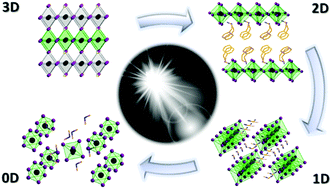White light emission in low-dimensional perovskites
Abstract
Low-dimensional perovskites are rapidly emerging due to their distinctive emission properties, consisting of ultrabroad and highly Stokes shifted luminescence with pure white light chromaticity, which makes them very attractive for solution-processed light-emitting devices and scintillators. To foster the design of new materials and their device applications, it is timely to review the relation between perovskite structural properties and the photophysical phenomena underlying their unique light emission characteristics. From a number of recent studies, it has emerged that broadband emission properties in metal halide frameworks are very common, stemming from the self-localization of small polaron species at specific sites of the inorganic lattice, with a wide energy distribution. This review aims to provide an account of the current understanding of the photophysical processes underpinning luminescence broadening and highly efficient emission in various classes of low-dimensional metal-halide frameworks, and to highlight their potential for solution-processed optoelectronic device applications. The discussion will additionally establish a wider perspective on the role of intrinsic and extrinsic self-trapping, formation of polarons and their effect on charge generation and transport in low-dimensional perovskites.

- This article is part of the themed collection: Recent Review Articles


 Please wait while we load your content...
Please wait while we load your content...